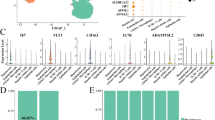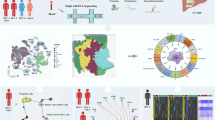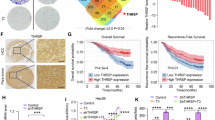Abstract
This study aimed to investigate the inhibitory effect of EM-2, a natural active monomer purified from Elephantopusmollis H.B.K., on the proliferation of human hepatocellular carcinoma cells and the molecular mechanism involved. The results from the MTT assay revealed that EM-2 significantly inhibited the proliferation of human hepatocellular carcinoma (HCC) cells in a dose-dependent manner but exhibited less cytotoxicity to the normal liver epithelial cell line LO2. EdU staining and colony formation assays further confirmed the inhibitory effect of EM-2 on the proliferation of Huh-7 hepatocellular carcinoma cells. According to the RNA sequencing and KEGG enrichment analysis results, EM-2 markedly activated the MAPK pathway in Huh-7 cells, and the results of Western blotting further indicated that EM-2 could activate the ERK and JNK pathways. Meanwhile, EM-2 induced apoptosis in a dose-dependent manner and G2/M phase arrest in Huh-7 cells, which could be partially reversed when treated with SP600125, a JNK inhibitor. Further study indicated that EM-2 induced endoplasmic reticulum stress and blocked autophagic flux in Huh-7 cells by inhibiting autophagy-induced lysosome maturation. Inhibition of autophagy by bafilomycin A1 could reduce cell viability and increase the sensitivity of Huh-7 cells to EM-2. In conclusion, our findings revealed that EM-2 not only promoted G2/M phase arrest and activated ER stress but also induced apoptosis by activating the JNK pathway and blocked autophagic flux by inhibiting autolysosome maturation in Huh-7 hepatocellular carcinoma cells. Therefore, EM-2 is a potential therapeutic drug with promising antitumor effects against hepatocellular carcinoma and fewer side effects.
Similar content being viewed by others
Log in or create a free account to read this content
Gain free access to this article, as well as selected content from this journal and more on nature.com
or
References
Wu J. The changing epidemiology of hepatocellular carcinoma in Asia versus United States and Europe. Adv Mod Oncol Res. 2017;3:51–8.
Jean-Luc R, Marine G. Hepatocellular carcinoma: slow progress in a booming epidemic. J Oncol Pract. 2017;13:365–6.
Shiffman ML. The next wave of hepatitis C virus: the epidemic of intravenous drug use. Liver Int. 2018;38:34–9.
Niu J, Lin Y, Guo Z, Niu M, Su C. The epidemiological investigation on the risk factors of hepatocellular carcinoma: a case-control study in Southeast China. Medicine. 2016;95:e2758.
Jeff H, Ahmed K, Economides MP, Manal H, Harrys T. Effect of sorafenib on hepatitis C viremia in cirrhotic patients with hepatocellular carcinoma. OFID. 2016;3(Suppl 1):459.
Francine G, Sylvain G, Stamatiki R, Annelise L, Barbara F, Nikolaus S, et al. Chemopreventive properties of apple procyanidins on human colon cancer-derived metastatic SW620 cells and in a rat model of colon carcinogenesis. Carcinogenesis. 2005;26:1291–5.
Dai X, Yin C, Zhang Y, Guo G, Zhao C. Osthole inhibits triple negative breast cancer cells by suppressing STAT3. J Exp Clin Cancer Res. 2018;7:322.
Tabopda TK, Ngoupayo J, Liu J, Shaiq Ali M, Khan SN, Ngadjui BT, et al. Further cytotoxic sesquiterpene lactones from Elephantopus mollis KUNTH. Chem Pharm Bull. 2008;56:231–3.
Gibert-Tisseuil F. Reflections on traditional Chinese medicine and its pharmacopoeia. Ann Pharm Fr. 1998;56:282–5.
Hasegawa K, Furuya R, Mizuno H, Umishio K, Sato K. Inhibitory effect of Elephantopus mollis HB and K. Extract on melanogenesis in B16 murine melanoma cells by downregulating microphthalmia-associated transcription factor expression. Biosci Biotechnol Biochem. 2010;74:1908–12.
Ooi KL, Muhammad TST, Mei LT, Sulaiman SF. Cytotoxic, apoptotic and anti-α-glucosidase activities of 3,4-di-O-caffeoyl quinic acid, an antioxidant isolated from the polyphenolic-rich extract of Elephantopus mollis Kunth. J Ethnopharmacol. 2011;135:685–95.
Ooi KL, Muhammad TST, Lam LY, Sulaiman SF. Cytotoxic and apoptotic effects of ethyl acetate extract of Elephantopus mollis Kunth. In human liver carcinoma HepG2 cells through caspase-3 activation. Integr Cancer Ther. 2014;13:NP1–9.
Shao F, Wang S, Li H, Chen W, Wang G, Ma D, et al. EM23, a natural sesquiterpene lactone, targets thioredoxin reductase to activate JNK and cell death pathways in human cervical cancer cells. Oncotarget. 2016;7:6790–808.
Low HB, Zhang Y. Regulatory roles of MAPK phosphatases in cancer. Immune Netw. 2016;16:85–98.
Johnson GL, Lapadat R. Mitogen-activated protein kinase pathways medicated by ERK, JNK, and p38 protein kinases. Science. 2002;298:1911–2.
Xu Z, Zhang F, Bai C, Yao C, Zhong H, Zou C, et al. Sophoridine induces apoptosis and S phase arrest via ROS-dependent JNK and ERK activation in human pancreatic cancer cells. J Exp Clin Cancer Res. 2017;36:124.
Mhaidat NM, Thorne R, Zhang XD, Hersey P. Involvement of endoplasmic reticulum stress in docetaxel-induced JNK-dependent apoptosis of human melanoma. Apoptosis. 2008;13:1505–12.
Tan G, Wang X, Tang Y, Cen W, Li Z, Wang G, et al. PP-22 promotes autophagy and apoptosis in the nasopharyngeal carcinoma cell line CNE-2 by inducing endoplasmic reticulum stress, downregulating STAT3 signaling, and modulating the MAPK pathway. J Cell Physiol. 2019;234:2618–30.
Zhang W, Liu H. MAPK signal pathways in the regulation of cell proliferation in mammalian cells. Cell Res. 2002;12:9–18.
Hetz C. The unfolded protein response: controlling cell fate decisions under ER stress and beyond. Nat Rev Mol Cell Biol. 2012;13:89–102.
Chen Z, Wu Q, Ding Y, Zhou W, Liu R, Chen H, et al. YD277 suppresses triple-negative breast cancer partially through activating the endoplasmic reticulum stress pathway. Theranostics. 2017;7:2339–49.
Ghosh AK, Mau T, O’Brien M, Garg S, Yung R. Impaired autophagy activity is linked to elevated ER-stress and inflammation in aging adipose tissue. Aging. 2016;8:2525–37.
Biczo G, Vegh ET, Shalbueva N, Mareninova OA, Elperin J, Lotshaw E, et al. Mitochondrial dysfunction, through impaired autophagy, leads to endoplasmic reticulum stress, deregulated lipid metabolism, and pancreatitis in animal models. Gastroenterology. 2018;154:689–703.
Kanno SI, Kurauchi K, Tomizawa A, Yomogida S, Ishikawa M. Pifithrin-alpha has a p53-independent cytoprotective effect on docosahexaenoic acid-induced cytotoxicity in human hepatocellular carcinoma HepG2 cells. Toxicol Lett. 2015;232:393–402.
Kobayashi N, Takada Y, Hachiya M, Ando K, Nakajima N, Akashi M. TNF-alpha induced p21(WAF1) but not Bax in colon cancer cells WiDr with mutated p53: important role of protein stabilization. Cytokine. 2000;12:1745–54.
Guo Y, Pan W, Liu S, Shen Z, Hu L. ERK/MAPK signalling pathway and tumorigenesis (Review). Exp Ther Med. 2020;19:1997–2007.
Ballif BA, Blenis J. Molecular mechanisms mediating mammalian mitogen-activated protein kinase (MAPK) kinase (MEK)-MAPK cell survival signals. Cell Growth Differ. 2001;12:397–408.
Kuma A, Mizushima N. Physiological role of autophagy as an intracellular recycling system: with an emphasis on nutrient metabolism. Semin Cell Dev Biol. 2010;21:683–90.
Mizushima N, Levine B. Autophagy in mammalian development and differentiation. Nat Cell Biol. 2010;12:823–30.
Hoo RLC, Shu L, Cheng KKY, Wu X, Liao B, Wu D, et al. Adipocyte fatty acid binding protein potentiates toxic lipids-induced endoplasmic reticulum stress in macrophages via inhibition of janus kinase 2-dependent autophagy. Sci Rep. 2017;7:40657.
Acknowledgements
This research was supported by the Science and Technology Project of Guangdong Province (No. 2016ZC0044), the Science and Technology Planning Project of Guangdong Province (No. 2018B030320007), the Clinical research projects of the first affiliated hospital of Jinan university (No. 2018008, 2019315). Meanwhile, this research was also supported by the Guangzhou Science and Technology Program (No. 202002030087) and the National Natural Science Foundation of China (No. 82074064).
Author information
Authors and Affiliations
Contributions
JWJ and XFZ contributed to the conception of the study. JY and ZDL contributed to the design, performance, and data analysis of the experiments. CYH and ZYL contributed to the writing and submitting of the paper. CYH contributed to the revise of this paper. XYZ and QL contributed to the collection and assembly of data. SYM and QZ contributed to the typesetting and correction of the paper. XFZ and JWJ contributed to the critical revision and final approval of the article.
Corresponding authors
Ethics declarations
Competing interests
The authors declare no competing interests.
Rights and permissions
About this article
Cite this article
Yang, J., Li, Zd., Hou, Cy. et al. EM-2 inhibited autophagy and promoted G2/M phase arrest and apoptosis by activating the JNK pathway in hepatocellular carcinoma cells. Acta Pharmacol Sin 42, 1139–1149 (2021). https://doi.org/10.1038/s41401-020-00564-6
Received:
Accepted:
Published:
Issue date:
DOI: https://doi.org/10.1038/s41401-020-00564-6
Keywords
This article is cited by
-
Petroleum ether extract of Elephantopus mollis induces senescence and inhibits invasion in breast cancer MDA-MB-231 cells
3 Biotech (2025)
-
EM-12, a natural sesquiterpene lactone extracted from Elephantopus mollis, promotes cancer cell apoptosis by activating ER stress
Medical Oncology (2025)
-
Apolipoprotein B100 acts as a tumor suppressor in ovarian cancer via lipid/ER stress axis-induced blockade of autophagy
Acta Pharmacologica Sinica (2025)
-
Gracillin suppresses cancer progression through inducing Merlin/LATS protein-protein interaction and activating Hippo signaling pathway
Acta Pharmacologica Sinica (2025)
-
Effect and underlying mechanism of a photochemotherapy dual-function nanodrug delivery system for head and neck squamous cell carcinoma
Journal of Translational Medicine (2024)



